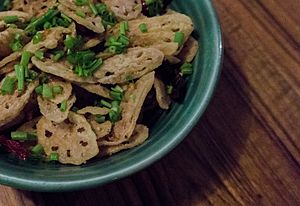Edible plant stem facts for kids
Edible plant stems are parts of plants that people eat. Plants have different parts like stems, roots, leaves, flowers, and fruits with seeds. Humans eat many of these parts!
For example, we eat seeds like maize (corn) and wheat. We enjoy fruits like tomatoes, avocados, and bananas. Some flowers we eat are broccoli. Popular leaves include lettuce, spinach, and cabbage. We also eat roots like carrots and beets. And of course, we eat stems, like asparagus. Did you know that celery and rhubarb are actually leaf stems (called petioles)?
Plant stems are super important. They hold up the whole plant, supporting its leaves, flowers, and fruits. Stems also connect the leaves to the roots. They act like tiny pipes, carrying water and minerals from the roots up to the leaves. They also move food made by the leaves to other parts of the plant. Stems help plants grow taller and wider. In some plants, like cactuses, stems can even store water or make food using sunlight!
Contents
What are Modified Stems?
Most stems grow above the ground. But some stems are special and grow in different ways. These are called modified stems. You can find them either above or below the ground.
Above-Ground Modified Stems
Some modified stems grow above the ground. These include:
- Phylloids: These look like leaves but are actually flattened stems.
- Stolons or Runners: These stems grow along the ground. They can create new plants at their tips, like strawberry plants do!
- Spurs: These are short, stubby stems that often bear flowers and fruits, especially on fruit trees.
Below-Ground Modified Stems
Other modified stems grow hidden beneath the soil. These include:
- Corms: These are short, swollen underground stems. They store food, like a taro plant.
- Rhizomes: These are horizontal underground stems. They can grow new shoots and roots, like ginger or bamboo.
- Tubers: These are swollen parts of an underground stem. They store a lot of food, like a potato.
Delicious Wild Plant Stems
Many wild plants also have edible stems! But remember, always be sure about what you're eating. It's best to learn from an expert before trying wild plants.
In North America, some wild edible stems include:
- Shoots of woodsorrel (often eaten with its leaves).
- Chickweeds and galinsoga.
- Common purslane.
- Japanese knotweed.
- Winter cress and other wild mustards.
- Thistles (but you need to remove their thorns first!).
- Stinging nettles (always cook these to remove the sting!).
- Bellworts, violets, amaranth, and slippery elm.
Some wild plants also have edible underground stems (rhizomes). Examples include arrowhead and cattail. Just like garden vegetables, wild edible stems are usually best when they are young and still growing. Many wild plants need special preparation before you can eat them safely. So, always do your research before trying any wild plant!


